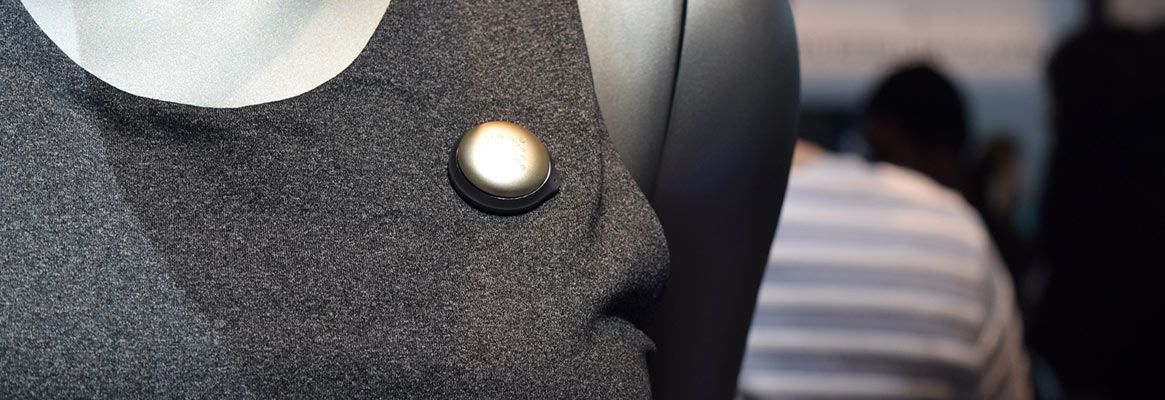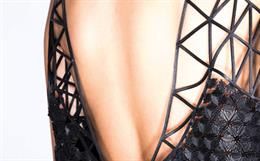Advances in textile technology, computer engineering andmaterials science are promoting a new breed of functional fabrics resulting insome truly smart and clever clothing. Realization of this vision could bepossible with the advent of wearable electronic textiles, where functionalityis incorporated into the fabric. Clothing is being developed for protection from chemical, biological and nuclear threats. Besides, with the development ofpolymers with exotic qualities in terms of their mechanical, electrical andmagnetic properties, scientists are ready to design electronic clothing withvarious specialties like heating, cooling, illuminating of body etc. Fashiondesigners are adding wires, circuits, and optical fibers to traditional textiles,creating garments that glow in the dark or keep the wearer warm.
Meanwhile, electronics engineers are sewing conductivethreads and sensors into body suits that can map users whereabouts and respondto environmental stimuli. Researchers agree that the development of genuinelyinteractive electronic textiles is technically possible, and that challenges inscaling up the handmade garments will eventually be overcome. Ideas include thedevelopment of jacket-sleeve keypads for controlling cell phones, pagers, orMP3 players, and sportswear with integral fabric sensors and display panels,ideas for monitoring heart rate and blood pressure during a gym workout ormorning run. Clothing fitted with textile global positioning system technologycould also be suitable for locating skiers or Mountaineers in bad weathers oreven for keeping a watch on young children.
Advances so far
Adopting electronic displays (LEDs) technologies to createcolorful, novelty clothing items for example, glow-in-the-dark bridal gown,sparkling cocktail dresses, and costumes for opera singer. Further progress is expected in the form of tailor-made clothing.
- Fibers powered by tiny, rechargeable batteries that are turned on by the wearer via a hidden switch causing the fibers to give shininess when the lights are dimmed.
- Development of a flexible, battery-powered optical fiber screen that can be woven into clothing. A prototype version integrated into a jacked displaying symbols is already in the market and more sophisticated versions may support advertising slogans, safety notices, or simply a range of different geometric patterns can be switched on and off.
- Production of low-cost jackets for joggers and walkers with a pulse monitor stitched to the left cuff. Embedded sensors control conductive material on the back of the jacket to keep the wearer warm should the temperature drop, while electroluminescent wires are fixed to pockets and hems to light up in the dark as a safety feature.
The marriage of woven fabric with electronics is findingfavor in the world of interior design as well inform of electro-textile wallpanels. The panel exploits reflective coloring. The fabric contains interwovenstainless steel yarns, painted with thermo-chromic inks, which are connected todrive electronics programmed to change color in response to heat from the conductingwires. At the outset, main users are going to be medical, military, andindustrial areas with compelling applications and affordability. The simulationenvironment is already being used to model a garment that can sense its ownshape thus helping patients to learn about their exercise requirement. Creatinga wearable version of a giant textile sensornet designed to detect noise.
It is envisaged that efforts should be to stay as close aspossible to conventional large-scale cutting and sewing techniques whenthinking about how electronic textile clothing could be made. Cuttingelectronic cloth clearly makes it more difficult to make good connections betweendifferent parts of the same garments and one solution to it could be the manufacturingof seamless clothing, which would avoid the cutting and stitching problem altogether. The cost of developing and manufacturing such sophisticated fabrics islikely to put them beyond the reach of the fashion industry for the time being.Connections will be main point of weakness in electronic clothing. Moreover,researchers have yet to answer the million-dollar question, perhaps critical toconsumer acceptance, about the washing of electronic fabrics. The challenge forindustry is also to build in the security and privacy for the user ofelectronic clothing from hackers. Whatever the technical obstacles, researchersinvolved in the development of interactive electronic clothing appearuniversally confident that context-aware coast and sensory shirts are only amatter of time.
Further Reading:
1) Meoli, D., May-Plumlee, T., J. Textile Apparel Technology Management 2 (2002) 1
2) Baard, M., E-Fabrics still too stiff to wear, wired news, 5 December 2002, www.wired.com/news/technology/0,1282,56708,00.html
3) Ball, P., Shoes and sheets get wired, Nature Science Update, 6 December 2002, www.nature.com/nsu_pf/021202/021202-11.html
4) Eisenberg, A., For the smart dresser, electric threads that cosset you, New York Times, 6 February 2003, pp.7, www.nytimes.com/2003/02/06/technology/circuits/06next.html?ex=1045545602&ei=1&en=419c725550669347
5) Hatcher, M., Fiber-optic dress goes down the aisle, Optics.org, 8 October 2002, www.optics.org/articles /news/8/10/11/1
6) Hatcher, M., France telecom debuts fiber screen, Optics.org, 2 July 2002, www.optics.org/articles /news/8/7/1/1
7) Ball, P., TV on a T-shirt, Nature Science Update, 22 May 2002, www.nature.com/nsu/020520/020520-4.html
8) Hogan, J., Fashion firm denies plan to track customers, New Scientists, 19 April 2003, pp 11
9) Yoshida, J., Benetton adopts Philips RFID technology for smart labels, EE Times, 14, March 2003, www.eetimes.com/story/OEG2003031150028
10) Gould, P., Textiles gain intelligence, Materials Today, October 2003, pp 38, www.materialstoday.com
About the Author:
The author is associated with the Department of Physics, SLIET, Distt.- Sangrur Punjab.
To read more articles on Textile, Industry, Technical Textile, Dyes & Chemicals, Machinery, Fashion, Apparel, Technology, Retail, Leather, Footwear & Jewellery, Software and General please visit http://articles.fibre2fashion.com
To promote your company, product and services via promotional article, follow this link: http://www.fibre2fashion.com/services/article-writing-service/content-promotion-services.asp








